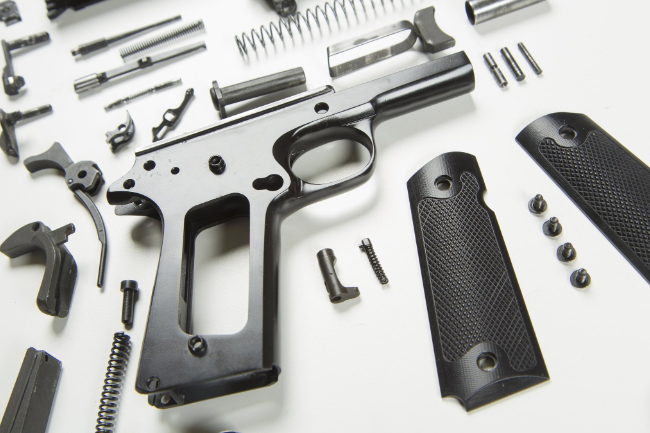
The strength of injection-molded gun parts compared to milled steel parts varies significantly due to the inherent differences in material properties and manufacturing processes. Here’s a detailed comparison of injection-molded plastic gun parts and milled steel parts, focusing on their strength and suitability for various applications.
Material Properties
- Injection-Molded Plastics:
- Common Materials: High-strength polymers such as glass-filled nylon, polycarbonate (PC), and acrylonitrile butadiene styrene (ABS).
- Tensile Strength: Typically ranges from 60-100 MPa for high-performance polymers and can exceed 150 MPa for glass-filled variants.
- Impact Resistance: Generally good, with some polymers offering excellent toughness.
- Density: Lower than steel, resulting in lighter components.
- Milled Steel:
- Types of Steel: Carbon steel, stainless steel, and alloy steels are commonly used.
- Tensile Strength: Can range from 250 MPa to over 1500 MPa, depending on the type and heat treatment.
- Impact Resistance: Very high, especially for toughened and tempered steels.
- Density: Much higher than plastics, leading to heavier components.
[elementor-template id=”4330″]
Strength Comparison
- Tensile Strength:
- Injection-Molded Plastics: Tensile strength is significantly lower than steel. Even with high-performance polymers, the tensile strength of plastics is only a fraction of that of steel.
- Milled Steel: Far superior in tensile strength, making it more suitable for load-bearing and high-stress applications.
- Impact Resistance:
- Injection-Molded Plastics: Certain plastics like polycarbonate have excellent impact resistance, which can be advantageous for parts that need to absorb shock or impact.
- Milled Steel: Exceptional impact resistance, particularly important for components subjected to sudden forces or impact.
- Durability and Wear Resistance:
- Injection-Molded Plastics: Generally good for non-load-bearing parts but can wear more quickly under friction and stress compared to steel.
- Milled Steel: Superior wear resistance, especially when treated with surface hardening techniques.
Applications in Firearms
- Injection-Molded Plastic Parts:
- Suitable Components: Non-critical components such as grips, stocks, magazine followers, and housings.
- Advantages: Lighter weight, lower cost, corrosion resistance, and ease of manufacturing complex shapes.
- Limitations: Lower strength and durability compared to steel, not suitable for high-stress components like barrels, bolts, or frames.
- Milled Steel Parts:
- Suitable Components: Critical, high-stress components such as barrels, bolts, frames, and action components.
- Advantages: High strength, durability, and wear resistance, essential for withstanding the pressures and forces in a firearm.
- Limitations: Heavier, more expensive to machine, and susceptible to corrosion without proper treatment.
Practical Considerations
- Weight Reduction:
- Using injection-molded plastic parts can significantly reduce the overall weight of a firearm, enhancing portability and reducing fatigue during use.
- Cost Efficiency:
- Injection molding is more cost-effective for mass production of complex shapes and non-critical components, while milled steel parts are more expensive due to material costs and machining time.
- Design Flexibility:
- Injection molding allows for more intricate designs and integration of features that would be difficult or costly to machine in steel.
[elementor-template id=”4331″]
Conclusion
Injection-molded plastic gun parts offer significant advantages in terms of weight reduction, cost, and design flexibility, making them suitable for non-critical components. However, when it comes to strength, durability, and performance under high stress, milled steel parts are far superior and essential for critical firearm components. The choice between injection-molded plastics and milled steel ultimately depends on the specific requirements of the firearm and the intended use of the parts.
Related Conten: Mold Manufacturing / 3D Printing
 DTG Mould Trade Process |
|
| Quote: | According to sample, drawing and specific requirement. |
|---|---|
| Discussion | Mold material, cavity number, price, runner, payment, etc. |
| S/C Signature | Approval for all the items. |
| Advance | Pay 50% by T/T |
| Product Design Checking | We check the product design. If some position is not perfect, or can not be done on the mould, we will send customer the report. |
| Mold Processing | Send report to customer once each week |
| Mold Testing | Send trial samples and try-out report to customer for confirmation |
| Mold Modification | According to customer’s feedback. |
| Balance Settlement | 50% by T/T after the customer approved the trial sample and mould quality. |
| Delivery | Delivery by sea or air. The forwarder can be designated by your side. |
 |
|

